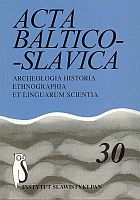Slavų šokamojo meno įtaka lietuvių choreografiniam folklorui
An Influence of Slavonic Dance Art to Lithuanian Choreographical Folklore
Author(s): Giedrė BarkauskaitėSubject(s): Customs / Folklore
Published by: Instytut Slawistyki Polskiej Akademii Nauk
Keywords: choreography; Lithuanian dance; folklore; Slavonic influence
Summary/Abstract: The first information in written trout Lithuanian choreography has been traced in the 11th century. An early written mines, where we could find any record on choreography, are very poor. Lithuanian choreography can be better reconstructed by the writings of the end of the 19th century and the first part of the 20th century. It is claimed that European choreographic art was influenced by other cultures at different times: up till 17th century European choreographic art was influenced by Italian and Spanish, up till 18th century – by French and English, and in the 19th century – by German and Slavonic dances. While exploring Lithuanian choreography of the 20th century, many elements of choreography with Slavonic origin were noticed. At the beginning of the 20th century a new branch of choreography called a National-dance was formed. National-dance takes its origins from authentic Lithuanian choreography. The choreography of National-Dance is influenced by choreography of other countries: In Lithuania national-dance was influenced mostly by Russian choreography. The way of forming Lithuanian national-dance can be explored while investigating unique cultural phenomenon in Lithuania – the Song Festivals. The Dancing Day program of the Song Festival clearly illustrates peculiarities of national-dance at different times. National-dance has originated on a basis of an authentic Lithuanian dance which existed at the turn of the 20th century. While investigating Lithuanian national-dance an influence of the choreography of other countries can not be found. While analizing a repertoire of the Dancing Day at the Song Festivals, any other kind at Slavonic choreographic influence except polka, upon national Lithuanian choreography can be hardly traced. An ethnochoreographical analysis showed that Lithuanian national-dance differs from its antecedent ethnic dance, because two of these choreographical genres embodies an absolutely separate lexis.
Journal: Acta Baltico Slavica
- Issue Year: 2006
- Issue No: 30
- Page Range: 643-650
- Page Count: 8
- Language: Lithuanian

